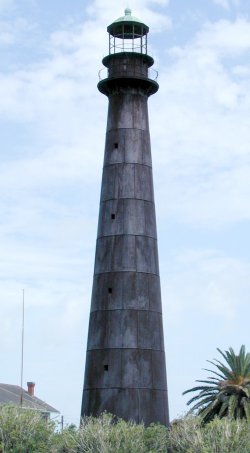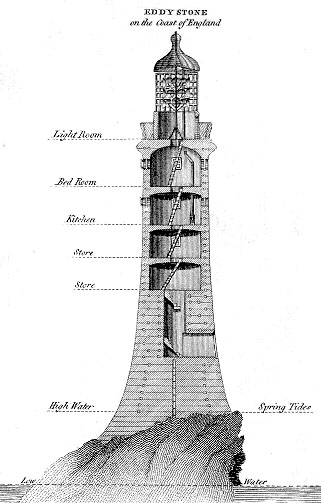Lighthouses and Cabooses
Today, we say goodbye to lighthouses and cabooses. The University of Houston's College of Engineering presents this series about the machines that make our civilization run, and the people whose ingenuity created them.
Remember railway train cabooses, those moving rear-observation towers that let an observer view the whole train? Electronic safety systems have made them obsolete. But cabooses are so woven into the fabric of railroading that, in 1980, railways were caught in a bitter debate as to whether they should be abandoned.
 It's that way with lighthouses as well. Lighthouses call up the romance of the sea just as powerfully as cabooses complete the image of railroading in our mind's eye. Lighthouses are used to mark all kinds of dangers to shipping at night -- sea-crossings, rocks, major landfalls. The distance from the light to the horizon depends on how high the lamp is, so height is important. A fifteen-foot light is visible four and a half miles away. A 120-foot light is visible for over twelve miles, and so forth.
It's that way with lighthouses as well. Lighthouses call up the romance of the sea just as powerfully as cabooses complete the image of railroading in our mind's eye. Lighthouses are used to mark all kinds of dangers to shipping at night -- sea-crossings, rocks, major landfalls. The distance from the light to the horizon depends on how high the lamp is, so height is important. A fifteen-foot light is visible four and a half miles away. A 120-foot light is visible for over twelve miles, and so forth.
That's why the Pharos at Alexandria was so large. One of the Seven Wonders of the Ancient World, it held a huge bonfire 400 feet in the air. And, like it, lighthouses down through the centuries have usually been tall masonry towers mounted on shore, or maybe on shoreline cliffs, burning wood or olive oil and later, coal or candles. It was, for a long time, a static technology. Rotating beams weren't invented until 1611. It was 1763 before reflectors were finally put behind lamps to boost their intensity. Lenses were introduced a scant two hundred years ago.
Lighthouse construction started moving again in 1698 when the English had to warn ships away from the Eddystone rocks, fourteen miles southwest of Plymouth. If you know about that lighthouse, it may well be because you've heard the old folk song:
Oh, me father was the keeper of the Eddystone Light,
And he slept with a mermaid one fine night.
And from this union there came three,
A porpoise and a porgy -- and the other was me.
Well, building the Eddystone light was a terrible job, and it greatly advanced the whole technology. It had to be erected right at sea level, where construction was hammered by waves. The first one, made of wood, lasted five years. The next, made of wood and iron, burned down after 47 years. The great engineer John Smeaton erected the third Eddystone Lighthouse in 1759. He used a new kind of interlocking stone construction that lasted until 1881.
But now radar, sonar, and electronic buoys are putting an end to lighthouses. Henceforth, you and I will live in a world without cabooses on trains, and without those beautiful storm-beaten minarets to call the weary sailor home.
The siren attraction of the lighthouse, like any good technology, is that it did a fine job of fulfilling human need. That's why it seems to reach far beyond function and to express something inside us. All good technology holds symbolic as well as functional power. That's why we're so loath to say good-bye to lighthouses -- or, for that matter, to railroad cabooses.
I'm John Lienhard, at the University of Houston, where we're interested in the way inventive minds work.
(Theme music)
For more on Smeaton and the Eddystone Light, see: Singer, C., Holmyard, E.J., Hall, A.R., and Williams, T.I., A History of Technology. Volume IV, The Industrial Revolution: c. 1750-1850. New York: Oxford University Press, 1958. (See index entries for Smeaton.)
This is a greatly revised version of Episode 89.

The Eddystone Light designed by John Smeaton
From the 1832 Edinburgh Encyclopaedia